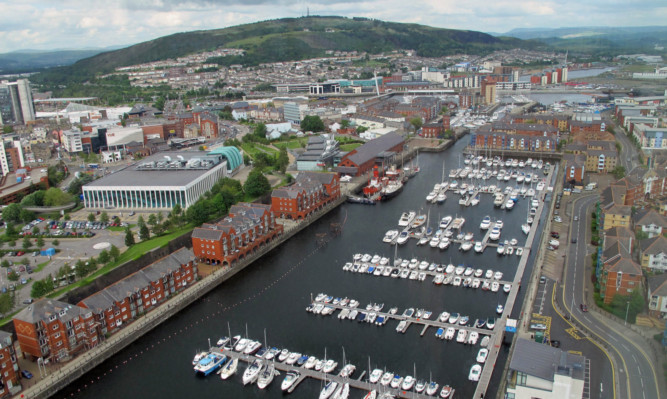In the first of a three-part series, Courier reporter Graeme Ogston visits one of Dundee’s City of Culture rivals, Swansea Bay.
With the Liberty Stadium gleaming in the valley as the train pulls into Swansea and a blue plaque to Badfinger singer Pete Ham on the station wall, it seems like culture will not be in short supply.
Not everyone was celebrating Swansea Bay making the shortlist, however.
“I don’t see much going on here,” said my taxi driver, in-between complaining about people smelling out his cab with illegally imported fish in their suitcases.
“It’s going downhill. If it wasn’t for the Waterfront, there’d be nothing.”
Quite a start I wondered if it was just one man’s jaded view.
The waterfront looms large, though, and wherever you go there the ghost of Swansea Bay’s most famous son is not far away.
The Dylan Thomas Centre, formerly Swansea Town Hall, is here, yards away from a theatre and sculpture devoted to the poet and author. Rubbing the bronze Dylan’s left foot is supposed to bring you luck.Day 2 of Graeme’s tour visits Leicester. See what he discovers in Friday’s CourierThe centre’s permanent exhibition is one of the area’s cultural big-hitters, a multi-media trip that even includes the doors to Thomas’s writing shed, rescued from a skip by an admirer.
“It’s not all about Dylan Thomas, there is so much more here,” insists Kev Johns, Swansea Sound breakfast show presenter and Swansea City FC chaplain “Mr Swansea” to locals.
We meet near the refurbished bus station and the bustling Swansea Market, a tourist favourite.
“The West End and Broadway are full of performers who you have never heard of who have been inspired by starting in Swansea,” he said.
“There are arts societies everywhere here for amateur productions as well as professional companies.”
Kev tells me how his friend and fellow Swansea lad, writer Russell T Davies, made sure Dr Who was filmed on the city’s streets.
He added: “A year of culture is not about high-brow culture. This city has been developing over the last 10 years like I’ve never known. We have not forgotten our heritage. But past is past and we are building a vibrant city.”
I see many galleries at the waterfront, but its biggest, Swansea Museum is obscured by the city’s never-ending roadworks. The nearby Glynn Vivian Art Gallery is closed for a multi-million pound redevelopment.
Getting hungry, I head back to the market. I’ve been told this is the best place for the Swansea classics cockles and laverbread, which is made with boiled seaweed and tastes far better than it looks.
I’m pleased to see lots of local art on display and buy a postcard in the Quadrant Centre before heading to the Mumbles, a seaside town 20 minutes down the coast which sits in the shadow of the 12th-Century Oystermouth Castle.
It now includes a not-for-the-faint-hearted glass bridge, allowing views from the castle unseen for hundreds of years.
Tourists pack out Joe’s ice cream shop, a feature of the town since 1922. I’ve been told it has the best ice cream in Wales (this may well be true, it was spectacular) and I was warned not to leave the Mumbles without trying it.
It is hard not to feel deja vu. Overlooked by a hill, Swansea Bay has a redeveloped waterfront, a largely pedestrianised city centre and a seaside town down the road with a castle and famous ice cream shop.
It certainly shares Dundee’s character and passion. Whether the taxi driver got it right or not remains to be seen.
